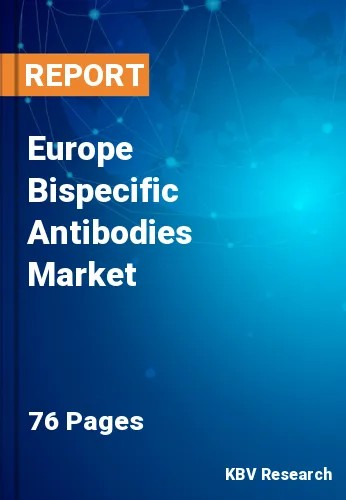Chapter 1. Market Scope & Methodology
1.1 Market Definition
1.2 Objectives
1.3 Market Scope
1.4 Segmentation
1.4.1 Europe Bispecific Antibodies Market, by Indication
1.4.2 Europe Bispecific Antibodies Market, by Country
1.5 Methodology for the research
Chapter 2. Market Overview
2.1 Introduction
2.1.1 Overview
2.1.1.1 Market Composition and Scenario
2.2 Key Factors Impacting the Market
2.2.1 Market Drivers
2.2.2 Market Restraints
Chapter 3. Competition Analysis - Global
3.1 KBV Cardinal Matrix
3.2 Recent Industry Wide Strategic Developments
3.2.1 Partnerships, Collaborations and Agreements
3.2.2 Trials and Approvals
3.2.3 Acquisition and Mergers
3.3 Top Winning Strategies
3.3.1 Key Leading Strategies: Percentage Distribution (2019-2023)
3.3.2 Key Strategic Move: (Partnerships, Collaborations and Agreements: 2020, Jun – 2022, Dec) Leading Players
Chapter 4. Europe Bispecific Antibodies Market by Indication
4.1 Europe Cancer Market by Country
4.2 Europe Inflammatory & Autoimmune Disorder Market by Country
4.3 Europe Others Market by Country
Chapter 5. Europe Bispecific Antibodies Market by Country
5.1 Germany Bispecific Antibodies Market
5.1.1 Germany Bispecific Antibodies Market by Indication
5.2 UK Bispecific Antibodies Market
5.2.1 UK Bispecific Antibodies Market by Indication
5.3 France Bispecific Antibodies Market
5.3.1 France Bispecific Antibodies Market by Indication
5.4 Russia Bispecific Antibodies Market
5.4.1 Russia Bispecific Antibodies Market by Indication
5.5 Spain Bispecific Antibodies Market
5.5.1 Spain Bispecific Antibodies Market by Indication
5.6 Italy Bispecific Antibodies Market
5.6.1 Italy Bispecific Antibodies Market by Indication
5.7 Rest of Europe Bispecific Antibodies Market
5.7.1 Rest of Europe Bispecific Antibodies Market by Indication
Chapter 6. Company Profiles
6.1 Amgen, Inc.
6.1.1 Company Overview
6.1.2 Financial Analysis
6.1.3 Regional Analysis
6.1.4 Research & Development Expenses
6.1.5 Recent strategies and developments:
6.1.5.1 Partnerships, Collaborations, and Agreements:
6.1.5.2 Acquisition and Mergers:
6.2 F. Hoffmann-La Roche Ltd.
6.2.1 Company Overview
6.2.2 Financial Analysis
6.2.3 Segmental and Regional Analysis
6.2.4 Research & Development Expense
6.2.5 Recent strategies and developments:
6.2.5.1 Partnerships, Collaborations, and Agreements:
6.2.5.2 Trials and Approvals:
6.3 Pfizer, Inc.
6.3.1 Company Overview
6.3.2 Financial Analysis
6.3.3 Regional & Segmental Analysis
6.3.4 Research & Development Expense
6.3.5 Recent strategies and developments:
6.3.5.1 Partnerships, Collaborations, and Agreements:
6.4 Akeso, Inc.
6.4.1 Company Overview
6.4.2 Financial Analysis
6.4.3 Regional Analysis
6.4.4 Research & Development Expenses
6.4.5 Recent strategies and developments:
6.4.5.1 Partnerships, Collaborations, and Agreements:
6.5 Johnson & Johnson (Janssen Global Services, LLC)
6.5.1 Company Overview
6.5.2 Financial Analysis
6.5.3 Segmental &Regional Analysis
6.5.4 Research & Development Expenses
6.5.5 Recent strategies and developments:
6.5.5.1 Partnerships, Collaborations, and Agreements:
6.5.5.2 Acquisition and Mergers:
6.6 Taisho Pharmaceuticals Holding Co., Ltd.
6.6.1 Company Overview
6.6.2 Financial Analysis
6.6.3 Segmental and Regional Analysis
6.6.4 Research & Development Expenses
6.7 Immunocore Holdings plc
6.7.1 Company Overview
6.7.2 Financial Analysis
6.7.3 Research & Development Expenses
6.7.4 Recent strategies and developments:
6.7.4.1 Partnerships, Collaborations, and Agreements:
6.8 GlaxoSmithKline PLC (GSK)
6.8.1 Company Overview
6.8.2 Financial Analysis
6.8.3 Regional Analysis
6.8.4 Research & Development Expense
6.9 Novartis AG
6.9.1 Company Overview
6.9.2 Financial Analysis
6.9.3 Segmental and Regional Analysis
6.9.4 Research & Development Expense
6.10. Allergan PLC (AbbVie, Inc.)
6.10.1 Company Overview
6.10.2 Financial Analysis
6.10.3 Regional Analysis
6.10.4 Research & Development Expense

